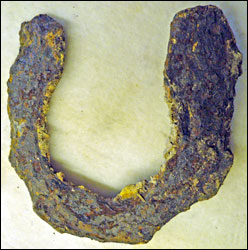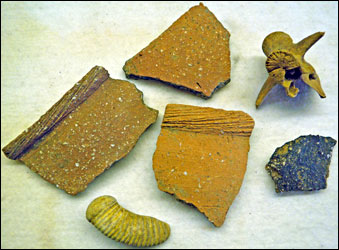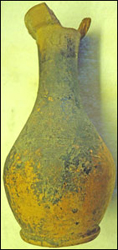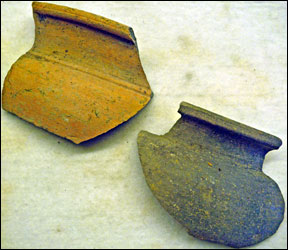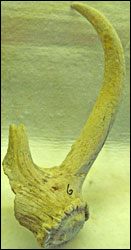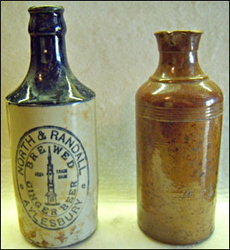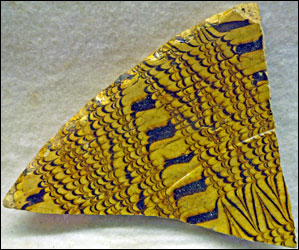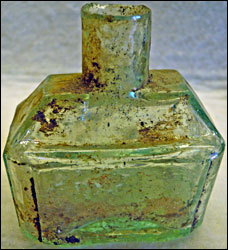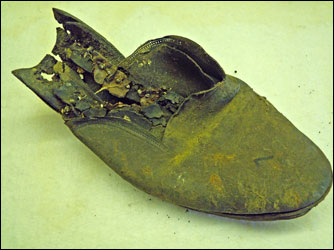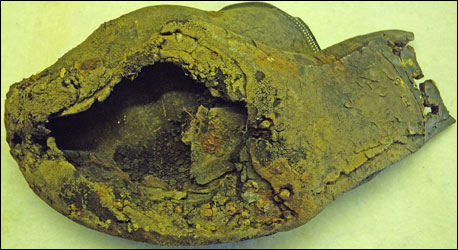|
John Marchant
Wharf Lane is part of the Roman Road from Cirencester to Irchester.
Having always been an active archaeologist I believe Old Stratford to have been an important site, situated on the strategic position of Watling Street and the River Ouse. I found extensive earthworks and ditches containing skeletons dating back to early Roman between my gravel pit and Old Stratford (all the finds are now with the local Archaeological Societies). The Romans used the sand and gravel: mortar for some of the older houses and walls around come from the pit.
When the garage on the A5 Towcester Road was being altered some years ago, I found very thick foundations of an old building.
|
|
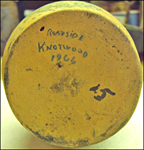 Roman pot with base
Roman pot with base
found near Knotwood in 1966
|
|
|
|
|
|
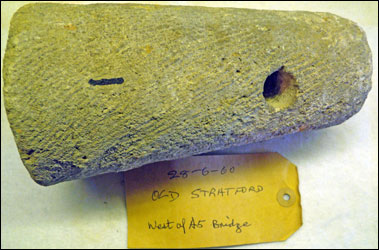 Fishing weight
Fishing weight
|

Rim of a pot found in the river Ouse at Old Stratford
|
|
The large number of weights found downstream of Stony Stratford bridge must have come from the fishery mentioned in 132027 when there was a dispute between Dom. John de Wolverton and John le Forester of Stony Stratford about the fisheries in the second riverbank of Dom. John from the bridge of Stony Stratford to the head of his pond and in the water near the river meadows of John le Forester from the bridge to Seintholospre. As a result John le Forester abandoned his claim on the fishing and agreed never to build a mill or divert water; in return he was granted “the right to fish with one Botour, (a corruption of bottorium meaning a net) of five feet width at the head of the bank and the other waters as far as Crikesarter, excepting a certain pool.
27. Ashmolean Library, MS D.D. Radcliffe, 260
|
By Dennis C. Mynard
Records of Bucks Vol. XXI 1979
The need to identify baskets would only be necessary at a shared fishery and identification is much more likely to have been carried out by a tag of some sort, perhaps metal, being secured to the basket. However, weights do sometimes have markings on them which must be for the purpose of identification. Some have been found with Roman numerals is carved on them. The weights are classified into types, the division being based on variations in form. These variations may indicate different sources of manufacture or the styles of various owners, since the types are found intermingled at most fisheries.
Use
Little is known of medieval fish traps. a baluster-shaped basket, narrow at the top and bottom but with a pronounced ‘belly’ in the centre. The bottom of the basket needs to be weighted in order to keep it in place and, as it is tubular in shape, it would easily accept the cylindrical shaft of the weights. The top of the basket is a simple cylindrical opening through which an eel or small fish could easily enter.
The shape of the weights, a cylindrical shaft with a head at one end, generally pierced through the shaft near the head, is clearly functional and was developed to fit a trap rather than a net.
The cylindrical shaft would be inserted into the bottom of the trap, the head acting as a stop. The weight would be secured by a peg or string through the pierced hole in the shaft, the union would then be completed by tying a string around the trap and the peg.
Removal of the weight would enable the removal of the fish from the basket trap, which would have had a baffle to stop the fish from escaping through the entrance. Therefore, the fish caught must have been small enough to pass through the end of the basket after removal of the weight.
No matter how well they were attached, the weights would occasionally become detached and remain at the bottom of the river. Similarly, if nets or baskets were left in the river they would perish but the weight would survive.

A complete basket preserved in Bedford Museum 8 is illustrated in Plate 1. It is a little over a yard (99 cm) long and the base is 6 cm in diameter. It is of modem date but may resemble the medieval basket traps if made to a traditional pattern.
Documentary Evidence
Extensive research has failed to reveal any substantial body of evidence referring to the methods used for fishing on inland rivers. Most books and papers on early fishing deal entirely with fishing in tidal waters. References to fishing baskets refer exclusively to the large weirs constructed in tidal rivers where basket traps known as Weeds and Putcheons were set up across the river to catch fish returning to the sea when the tide was on the ebb. Only one reference to basket traps in mill streams has come to hand: it is in a government report on salmon fishing in 1860.10 The report states that 'it was a very common practice to place baskets in the mill stream to catch the fry'.
|
|
The Wolverton Express April 12th 1974
Old Stratford: a resting place for Roman Legions?
I have been reading the recent book, Passenham, by Dr. O. F. Brown and Mr. G. J. Roberts and note with great interest their opinion that there was probably a strategic encampment at Old Stratford, on the higher ground commencing the river crossing.
The viatores in Roman Roads in the SE Midlands.
“Owing to the distance of about 16 miles between Magiovinium (Dropshort) and Lactodorum (Towcester), which would appear too long for one day’s march, there may have been a posting station at the halfway point, at Old Stratford or Stony Stratford, which are conveniently situated by a river. The fact that Roman roads cross the Watling Street here appears to bear this out.”
The Antonine Itinerary (Map of Roman Britain 3rd Edition 1956) gives a distance of about 12 Roman
miles between Dunstable and Dropshort, 12 between Towcester and Bannaventa (Whilton Lodge) but 16 between Dropshort and Towcester.
The distances between most Roman places on Watling Street are usually 11 or 12 Roman miles. Surely then the Romans, with their organising genius, would have made an encampment about half-way along that 16 miles, at Old Stratford, a ford by a river, probably a much wider and perhaps a faster flowing river than today.
Additional evidence of a settlement at Old Stratford is given in a rather curious book in Stony Stratford Library. The London that was Rome, by Michael Harrison (Allen and Unwin 1971). By going back to the Old Latin and British (Welsh) names for streets, churches and pubs, the author has worked out what they were in Roman days and claims many of his findings have later been proved by excavations.
There was once a Saracens Head pub in Old Stratford. Michael Harrison writes that the name Saracen's Head, has nothing to do with either Saracens or with heads but was originally a sarcinaria — the military store where the soldier could "dump" his baggage.
This explains why the various "Saracen's Heads" are to be found INSIDE a gate.
Could the Legions of Suetonius in 61 AD, as they forced march down Watling Street from Anglesey in a vain endeavour to protect London from Boadicea, have piled their arms in Old Stratford?
And if Old Stratford was a camp it seems likely that ribbon development took place along Watling Street and Stony Stratford was born with pubs, brothels, etc.
Here again Harrison's book may give us a few clues: Cock Inn —Coquina — Coquin — Cock Inn from Coquina, a cookshop. There are many Cock Inns throughout Britain, and all derive from the old word for cook shop. White Hart, all pub names which begin with White — White Lion. White Hart (hortus, a garden). etc. — contain at least one Latin word, viteus, to do with wine.
I have but little Latin and less Welsh but perhaps some of you learned readers might like to comment.
Montague K. Hare
42 Calverton Road
Stony Stratford
|
|
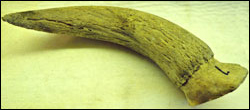 Horns and jaw bone of various animals
Horns and jaw bone of various animals
found in ancient pits in Old Stratford
|
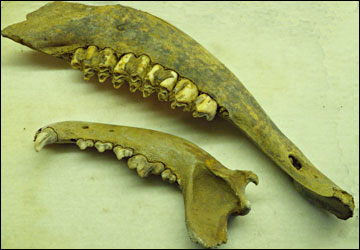 |
|
More modern finds from Old Stratford
|
|
|
|
|
|
Medieval pottery
|
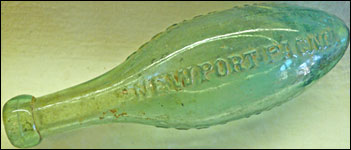 |
|
Glass bottle from Newport Pagnell
|
|
|
|
|
|
|
|
|
Shoe found in the river Ouse
|
|


